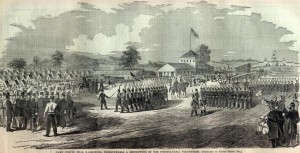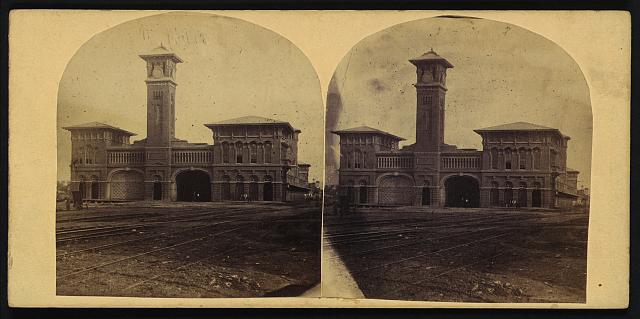Provost Guard has its work cut out for it at Camp Curtin.
Richmond’s Daily Dispatch says the removal of native Pennsylvanian George McClellan as commander of the Army of the Potomac has caused an increase in the turbulence at Camp Curtin, the training camp for recruits near Harrisburg. One of the underlying issues appears to be the drafted men’s resistance to breaking up the new regiments they joined, so that they could be made to fill up the old regiments.
From the Richmond Daily Dispatch November 15, 1862:
Pennsylvania Obstinate — Apprehended Difficulties between the drafted men and the Provost Guard.
The removal of McClellan has brought things to a fever heat in Pennsylvania. The Philadelphia Inquirer, of the 12th, alluding to the precarious state of affairs at Camp Curtin, the principal camp of the drafted men of the “Keystone” State, says:
The State of feeling at Camp Curtin is unsettled, so far as the drafted men are concerned. The objections to going into the old regiments are persisted in, while the idea of giving up their company organizations is regarded as an act of tyranny. It is in contemplation to test the matter legally. The purpose is to bring a case before a court, and test whether the men drafted can claim the provision and protection of the State law under which they were called into service, or whether the officers now in the service can force the drafted men in the old regiments. This would be the proper and the safe means of settling what is really a grave difference,
The duty of the Provost guard at present is of a character at once onerous and dangerous. They occupy a position which is not fairly understood by the men in Camp Curtin, with whom a difficulty exists as to their disposal in companies and regiments. The Provost guard are bound to execute their orders. They are soldiers who know nothing but obedience, and it is to be hoped that the drafted men will not tempt the Provost guard into what might seem to be, if not actually become, bloody force. On the night of the 5th, the guard, while on duty, were very badly treated by the men in Camp Curtin. They were assailed with stones, thrown by men concealed behind tents, and otherwise rudely attacked by the drafted men. Insubordination of this kind is disgraceful to the guilty.
Since the differences and dissatisfactions among the drafted men, large numbers have deserted, and the purpose to do so is also avowed by still larger numbers of the men now in Camp Curtin. Every hour adds to the embarrassment. On the 6th inst., one of the men, in attempting to break the guard, was shot in the leg, and severely if not dangerously wounded.
And, as The American Civil War points out, there was a lot of resistance to the 1862 draft in Pennsylvania even before the men got to camp:
On Oct. 16, the draft began in every county in Pennsylvania except Philadelphia. The nation’s most serious resistance to conscription broke out Oct. 17, in Berkley, Luzerne County, where the military fired on a mob of rioters and killed 4 or 5 of them. Resistance also flared in Carbondale, Scranton, and other regions in the coal country, mostly among the Irish.
Gov. Curtin wrote to Secretary of War Stanton on Oct. 22: “The draft is being resisted in several counties of the State. In Schuylkill County I am just informed that 1,000 armed men are assembled, and will not suffer the train to move with the drafted men to this place. I wish ample authority to use my troops in the State, and particularly the regulars and Anderson Cavalry at Carlisle, to crush this effort instantly. We will thus enforce the law, and effectually, if successful, prevent the like occurring in other parts of the State.”
Camp Curtin Historical Society and Civil War Roundtable publishes periodic newsletters; it’s most recent features a biography of McClellan, including the flag system he developed to improve communication in his army.
The first image of Camp Curtin along with a couple paragraphs about the early patriotic fervor in Pennsylvania can be found at Son of the South. Drill-sergeants at Camp Curtin drill cheerful volunteers from “daylight till dark.” The second image from September 1862 is found at the same site.



